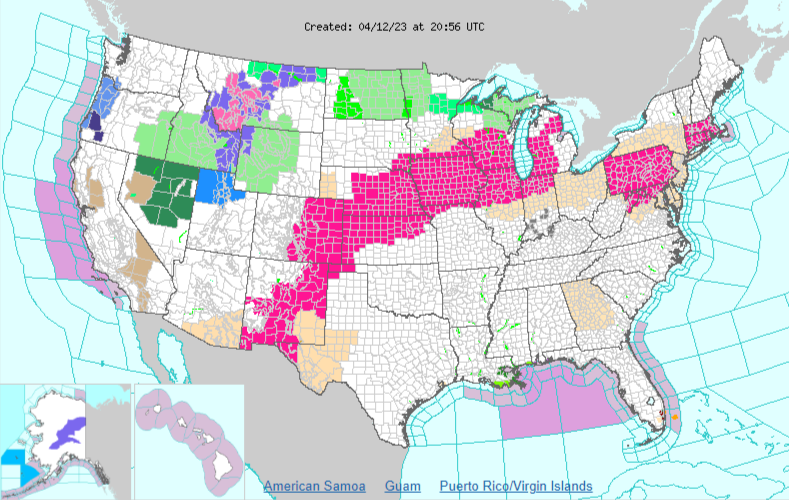UPDATED: April 13, 10:40 a.m.
PHILADELPHIA (KYW Newsradio) — A New Jersey wildfire tore through 6 square miles of the state's pine barrens, raining down embers miles away and confronting firefighters with a 200-foot wall of flame.
No one has been injured, and no homes have been damaged. By Thursday morning, fire officials announced that 100% of the blaze has been contained.
It all happened in New Jersey but could happen in almost every part of the country this week, according to the National Weather Service, which issued so-called “red flag warnings” on Wednesday for 20 states spanning the nation. The agency cautioned that dry conditions and strong winds have raised the danger of forest fires elsewhere, too.

The wildfire started in Manchester Township, just outside of Toms River. The New Jersey Forest Fire Service said it took just six hours for it to grow to 2,500 acres Tuesday night. By 10 a.m. Wednesday, officials said the fire spanned 3,859 acres. At least 170 buildings were forced to evacuate in Manchester and Lakehurst, but residents were allowed to return to their homes around 8 a.m.
“We saw the red glow in the sky, and every time the wind would shift, it got worse,” said Jason Cylenica, who lives in the neighborhood closest to the fire. His wife, Cynthia Tiemper, said burning embers were landing in their backyard Tuesday night, making them decide to evacuate even before the fire department knocked on their door at 10:45 p.m.
“We left so fast I didn't even bring socks,” she said. “It was like, ‘You grab the dog, I’ll grab this and let's go.’ When we got back here this morning and saw that everything was still here, it was like prayers had been answered."
Firefighters initially tried to keep the blaze — named the Jimmy's Waterhole fire after a waterhole where the blaze was particularly intense — from crossing Route 539, but couldn't stop the flames, officials said. Eventually, a perimeter, using pavement, roadways and other barriers was constructed. There were some 75 firefighters, two helicopters, 15 fire engines — and some bulldozers — involved.
John Cecil, an assistant commissioner in the state's Department of Environmental Protection, said he was in the thick of it Tuesday night with incident commanders, and it was no joke.
“This fire exhibited extreme fire behavior,” he said. “I don’t mean to be dramatic, but this was a severe situation that these guys and gals managed to keep in a place and protect lives and property from that.”
Trevor Raynor, assistant division fire warden with the New Jersey Forest Fire Service, said the blaze spread so fast because of the current leaf-off season.
“That warm sun penetrates the open canopy of the trees right now since we haven’t greened up, so the forest floor and all the fuels are very dry,” he explained. “Should there be an ignition source, wildfires spread quickly.”
April is the peak month for forest fires in New Jersey, officials said. And despite its status as the nation's most densely populated state, 40% of the state is forest land. There are about 1,500 wildfires a year in New Jersey, according to the Forest Fire Service.
Although the state is not in a drought, there's no chance of rain until the weekend in the part of New Jersey where the fire is burning. Statewide campfire and agricultural burning restrictions are currently in place.
Forest fires are a common occurrence in the Pine Barrens, a 1.1 million-acre state and federally protected reserve about halfway between Philadelphia to the west and the Atlantic coast to the east. On Wednesday afternoon, the Forest Fire Service was responding to another blaze in West Milford in the northwest portion of the state near Route 23, but estimates of the size of that fire were not immediately available.
Greg McLaughlin, chief of the New Jersey Forest Fire Service said the fire began on the grounds of Joint Base McGuire-Dix-Lakehurst, a military facility spanning several municipalities at about 4 p.m. Tuesday. Military personnel tried to extinguish it, but winds soon spread the fire beyond the base's perimeter and across a busy highway, Route 539, necessitating a large response from numerous municipalities in the region.
A cause of the fire wasn’t given, but authorities said they’re investigating.
In the parking lot of a firehouse miles away from the fire scene, McLaughlin held up a plastic bag filled with small pieces of charred wood — dead embers that had flown through the air over 2 miles away and threatened to start new fires.
Last month, a wildfire in the Pine Barrens threatened over a dozen homes in Little Egg Harbor, not far from the site of a massive forest fire in 2007 at the New Jersey Air National Guard’s Warren Grove target range, which burned nearly 27 square miles.
Fire is an essential element of the Pine Barrens ecosystem; many of the pine trees there rely on heat from fires to release seeds from their cones, providing for the growth of new trees.
NBC10 is a broadcast partner of KYW Newsradio. The Associated Press contributed to this report.

